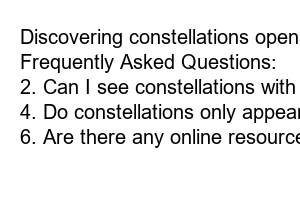별자리 찾는법
Title: The Ultimate Guide: How to Find Constellations
Subheading 1: Introduction (40 words)
Unlock the secrets of the night sky by learning how to find and identify constellations! In this comprehensive guide, we will walk you through simple techniques to locate these beautiful patterns, allowing you to connect with the universe in a whole new way.
Subheading 2: Familiarize Yourself with the Night Sky (50 words)
Before diving into identifying constellations, it’s crucial to get acquainted with the night sky. Familiarize yourself with the major landmarks like the Moon, North Star, and the Milky Way. Understanding these key reference points will lay the foundation for successful constellation spotting.
Subheading 3: Prepare for Stargazing (60 words)
To make the most of your stargazing experience, ensure you have the right equipment such as binoculars or a telescope and choose a location away from city lights for optimal visibility. Remember to bundle up and bring a star chart or smartphone app to help navigate the night sky.
Subheading 4: Learn the Key Constellations (70 words)
Start by focusing on a few *bright and prominent* constellations that are visible year-round, such as Ursa Major (the Big Dipper) and Orion (the Hunter). Recognizing these well-known patterns will help you orient yourself and locate other constellations nearby.
Subheading 5: Utilize Stellar Patterns (65 words)
Each constellation is composed of stars that form recognizable patterns. By identifying these patterns, you can trace the lines between stars and see the constellation take shape. Look for distinct shapes like triangles, squares, or the famous heavenly archer of Sagittarius. Practice identifying these patterns, and soon you’ll be able to spot even the faintest formations.
Subheading 6: Create Celestial Connections (50 words)
Connecting constellations with relatable stories or mythological characters can enhance your stargazing experience. Explore the rich history behind each constellation, and it will become easier to recall their positions in the sky, transforming your nights into captivating journeys through ancient lore.
Subheading 7: Stay Curious & Keep Exploring (45 words)
As with any new skill, practice is key. Embrace the excitement of exploring the night sky and continue seeking out new constellations. Gain confidence by starting with the easier-to-find constellations before venturing into those that are more challenging. Remember, each discovery is an opportunity to expand your celestial knowledge.
Summary:
Discovering constellations opens up a world of wonder and beauty. By familiarizing yourself with the night sky, preparing for stargazing, and learning key constellations, you can embark on a captivating journey through the universe. Use stellar patterns, connect constellations with stories, and never stop exploring. Happy stargazing and remember to keep looking up!
Frequently Asked Questions:
1. What is the easiest constellation to identify?
2. Can I see constellations with the naked eye?
3. How can I differentiate between a constellation and a star?
4. Do constellations only appear at night?
5. What is the significance of constellations in different cultures?
6. Are there any online resources to help me learn more about constellations?

